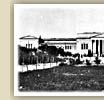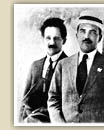
The disillusionment and criticism following the defeat in war, the vision
of a new Greece, patriotism, national integration, social transformation, the
movement of people from the countryside to the city, the pursuit of a national
character in arts, the introduction of philosophical, socio-political
concepts and artistic movements from Europe - all these had complex repercussions on the
cultural and intellectual pursuits of the period.
Poetry was influenced by European Symbolism. The most significant intellectual figures
imbued their work with their views about the times and the fate of
Hellenism. Kostis Palamas's most important work explored
national issues but were also visionary. A poet of the Greek diaspora, a Greek
from Alexandria, Constantine Cavafy, created a body of poetic work
unparalleled in Modern Greek and world literature.
At the same time, three prominent figures of modern Greek literature made their appearance:
Angelos Sikelianos, Nikos Kazantzakis and
Kostas Varnalis.
Philosophical and political concepts, especially socialist ideals
originating from Europe, shaped the ideological and artistic world. These new
views were disseminated chiefly through periodicals, especially literary ones, which were
vehicles of discussion for the intellectuals of the time, literary criticism and innovative tendencies that were intimately linked with the issues of language and education.
Prose writers tended to cultivate demotic Greek and either focused on folkloric realism (ethography)
or cultivated social prose. The Macedonian Struggle, national integration and faith in Greek potential inspired other intellectuals and writers, and
national issues and Hellenism in general were the core elements in much of their work.
|
 |

Theatre in general and playwriting in particular enjoyed a revival in this period, when a veritable Greek dramatic tradition was created. Music also acquired, for the first time, a national character and a national Greek school developed.
European movements spread to Greece and were transcribed
into a Greek artistic idiom. New tendencies in painting
and sculpture began to put aside the academicism of the previous period,
which still, however, dominated, whereas engravingand
photographydeveloped artistic independence. Important artists, such as Konstantinos Parthenis,
Konstantinos Maleas and Yorgos Bouzianis emerged in this period; the latter
marked the shift from tradition
to modernism.
In general this is an age that saw the transition from traditional to modern
art forms - forms that only developed to their full capacity in the subsequent, inter-war period. But in these years the painter Theophilos Hatzimichail produced his unique work, illustrating the uninterrupted Greek
tradition and emerging as the teacher of 'Greekness', as acknowledged by the writers
of the following generation of the 1930s.
The arts thrived and more and more painting exhibitions were organized
(collective and individual) from 1901 onwards. Etaireia Philotechnon (Society of the Friends of Art)
organized exhibitions at Koupas Megaron, Elliniki Kallitechniki Etaireia (Hellenic Arts Society)
at Zappeion. In 1900 the first arts society, Syndesmos Ellinon Kallitechnon (Society of Greek
Artists) was founded and was followed by others. In 1900 the National Gallery was established.
Syllogos pros diadosin ton ofelimon vivlion (The Society for the dissemination of useful books) was
established in 1898 and contributed much to intellectual life.
The study of the Greek past developed apace.
The main ideological concern of Greek society at the beginning of the
twentieth century was the Language Question. The struggle for the dominance of demotic Greek,
which was related to demands for wider socio-political reforms, was inseparably linked to educational reform. It brought together many of the prominent figures of Greek letters and culture,
despite the differences among them, which chiefly concerned the socio-political connotations
of demoticism. The era was characterized by great militancy and has been called the 'heroic age of demoticism'.
For the first time, demoticists came together in organizations and took on
a more dynamic role in the intellectual life of the country.
Space, as landscape, became the subject of a Greek aesthetic theory,
the creation of Periclis Yannopoulos, but also inspired painting,
which revealed and lent artistic form to Greek landscape and light.
As cities grew, the urban milieu invaded literature,
which thus followed the movements of population and social transformation (except in the case of the countryside, which was
depicted in folkloric realism or ethography).
Architecture pursued the Neo-classical style of the previous century, but at the same time
new forms began to emerge: the pursuit of a Greek architecture, based on the study of traditional, and especially
Byzantine, architecture. These ideas were theoretical only at this stage, and were only implemented by future generations. |
 |
